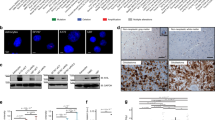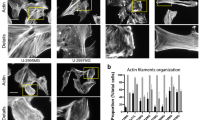Abstract
Malignant astrocytomas are highly infiltrative neoplasms that invade readily into regions of normal brain. On a cellular basis, the motility and invasiveness of human cancers can be ascribed in part to complex rearrangements of the actin cytoskeleton that are governed by several actin-binding proteins. One such actin-binding protein that has been linked to the invasive behavior of carcinomas is fascin, which serves to aggregate F actin into bundles. In this study, we examined the expression of fascin in a series of human malignant astrocytomas (WHO grades I–IV). Five grade I, 5 grade II, 10 grade III, and 26 grade IV human astrocytomas were examined for fascin and glial fibrillary acidic protein (GFAP) expression by double immunofluorescence confocal microscopy. Expression of fascin and GFAP was also determined by Western blot analysis. Fascin expression increased with increasing WHO grade of astrocytoma. This is in marked contrast to GFAP expression, which decreased with increasing WHO grade. In grades I and II neoplasms, and within non-neoplastic brain, fascin and GFAP were expressed diffusely within regions examined. However, in the higher-grade astrocytomas (grades III and IV), fascin and GFAP were expressed regionally in distinctly separate tumor cell populations. This is the first study to demonstrate the expression of fascin in human astrocytic neoplasms. The role that fascin plays in contributing to the invasive phenotype of anaplastic astrocytomas awaits further study and investigation.
Similar content being viewed by others
References
Fukuyama K, Matsuzawa K, Hubbard SL, et al (1996) Analysis of glial fibrillary acidic protein gene methylation in human malignant gliomas. Anticancer Res 16:1251–1257
Rutka JT, Hubbard SL, Fukuyama K, et al (1994) Effects of antisense glial fibrillary acidic protein complementary DNA on the growth, invasion, and adhesion of human astrocytoma cells. Cancer Res 54:3267–3272
Rutka JT, Ackerley C, Hubbard SL, et al (1998) Characterization of glial filament-cytoskeletal interactions in human astrocytomas: an immuno-ultrastructural analysis. Eur J Cell Biol 76:279–287
Rutka JT, Ivanchuk S, Mondal S, et al (1999) Co-expression of nestin and vimentin intermediate filaments in invasive human astrocytoma cells. Int J Dev Neurosci 17:503–515
Tsuiki H, Nitta M, Tada M, et al (2001) Mechanism of hyperploid cell formation induced by microtubule inhibiting drug in glioma cell lines. Oncogene 20:420–429
Yoshida D, Hoshino S, Shimura T, et al (2000) Drug-induced apoptosis by anti-microtubule agent, estramustine phosphate on human malignant glioma cell line, U87MG; in vitro study. J Neurooncol 47:133–140
Terzis AJ, Thorsen F, Heese O, et al (1997) Proliferation, migration and invasion of human glioma cells exposed to paclitaxel (Taxol) in vitro. Br J Cancer 75:1744–1752
Nakamura Y, Takeda M, Angelides KJ, et al (1991) Assembly, disassembly, and exchange of glial fibrillary acidic protein. Glia 4:101–110
Dirks PB, Patel K, Hubbard SL, et al (1997) Retinoic acid and the cyclin dependent kinase inhibitors synergistically alter proliferation and morphology of U343 astrocytoma cells. Oncogene 15:2037–2048
Abbracchio MP, Camurri A, Ceruti S, et al (2001) The A3 adenosine receptor induces cytoskeleton rearrangement in human astrocytoma cells via a specific action on Rho proteins. Ann NY Acad Sci 939:63–73
Marushige Y, Marushige K, Okazaki DL, et al (1989) Cytokeletal reorganization induced by nerve growth factor and glia maturation factor in anaplastic glioma cells. Anticancer Res 9:1143–1148
Langlois A, Lee S, Kim DS, et al (2002) p16(ink4a) and retinoic acid modulate rhoA and GFAP expression during induction of a stellate phenotype in U343 MG-A astrocytoma cells. Glia 40:85–94
Bartles JR, Wierda A, Zheng L (1996) Identification and characterization of espin, an actin-binding protein localized to the F-actin-rich junctional plaques of Sertoli cell ectoplasmic specializations. J Cell Sci 109:1229–1239
Cohan CS, Welnhofer EA, Zhao L, et al (2001) Role of the actin bundling protein fascin in growth cone morphogenesis: localization in filopodia and lamellipodia. Cell Motil Cytoskeleton 48:109–120
Deck JH, Eng LF, Bigbee J, et al (1978) The role of glial fibrillary acidic protein in the diagnosis of central nervous system tumors. Acta Neuropathol (Berl) 42:183–190
McLendon RE, Bigner DD (1994) Immunohistochemistry of the glial fibrillary acidic protein: basic and applied considerations. Brain Pathol 4:221–228
Selmaj K, Shafit-Zagardo B, Aquino DA, et al (1991) Tumor necrosis factor-induced proliferation of astrocytes from mature brain is associated with down-regulation of glial fibrillary acidic protein mRNA. J Neurochem 57:823–830
Adams JC (1995) Formation of stable microspikes containing actin and the 55 kDa actin bundling protein, fascin, is a consequence of cell adhesion to thrombospondin-1: implications for the anti-adhesive activities of thrombospondin-1. J Cell Sci 108:1977–1990
Ishikawa R, Yamashiro S, Kohama K, et al (1998) Regulation of actin binding and actin bundling activities of fascin by caldesmon coupled with tropomyosin. J Biol Chem 273:26991–26997
Yamashiro S, Yamakita Y, Ono S, et al (1998) Fascin, an actin-bundling protein, induces membrane protrusions and increases cell motility of epithelial cells. Mol Biol Cell 9:993–1006
Ross R, Ross XL, Schwing J, et al (1998) The actin-bundling protein fascin is involved in the formation of dendritic processes in maturing epidermal Langerhans cells. J Immunol 160:3776–3782
Ross R, Jonuleit H, Bros M, et al (2000) Expression of the actin-bundling protein fascin in cultured human dendritic cells correlates with dendritic morphology and cell differentiation. J Invest Dermatol 115:658–663
Saishin Y, Shimada S, Morimura H, et al (1997) Isolation of a cDNA encoding a photoreceptor cell-specific actin-bundling protein: retinal fascin. FEBS Lett 414:381–386
Yamakita Y, Ono S, Matsumura F, et al (1996) Phosphorylation of human fascin inhibits its actin binding and bundling activities. J Biol Chem 271:12632–12638
Ono S, Yamakita Y, Yamashiro S, et al (1997) Identification of an actin binding region and a protein kinase C phosphorylation site on human fascin. J Biol Chem 272:2527–2533
Adams JC, Clelland JD, Collett GD, et al (1999) Cell-matrix adhesions differentially regulate fascin phosphorylation. Mol Biol Cell 10:4177–4190
Holthuis JC, Schoonderwoert VT, Martens GJ (1994) A vertebrate homolog of the actin-bundling protein fascin. Biochim Biophys Acta 1219:184–188
Edwards RA, Bryan J (1995) Fascins, a family of actin bundling proteins. Cell Motil Cytoskeleton 32:1–9
Adams JC (1997) Characterization of cell-matrix adhesion requirements for the formation of fascin microspikes. Mol Biol Cell 8:2345–2363
Adams JC, Kureishy N, Taylor AL (2001) A role for syndecan-1 in coupling fascin spike formation by thrombospondin-1. J Cell Biol 152:1169–1182
Sasaki Y, Hayashi K, Shirao T, et al (1996) Inhibition by drebrin of the actin-bundling activity of brain fascin, a protein localized in filopodia of growth cones. J Neurochem 66:980–988
Kureishy N, Sapountzi V, Prag S, et al (2002) Fascins, and their roles in cell structure and function. Bioessays 24:350–361
Adams JC, Schwartz MA (2000) Stimulation of fascin spikes by thrombospondin-1 is mediated by the GTPases Rac and Cdc42. J Cell Biol 150:807–822
Jawhari AU, Buda A, Jenkins M, et al (2003) Fascin, an actin-bundling protein, modulates colonic epithelial cell invasiveness and differentiation in vitro. Am J Pathol 162:69–80
Fan G, Kotylo P, Neiman RS, et al (2003) Comparison of fascin expression in anaplastic large cell lymphoma and Hodgkin disease. Am J Clin Pathol 119:199–204
Goncharuk VN, Ross JS, Carlson JA (2002) Actin-binding protein fascin expression in skin neoplasia. J Cutan Pathol 29:430–438
Grothey A, Hashizume R, Sahin AA, et al (2000) Fascin, an actin-bundling protein associated with cell motility, is upregulated in hormone receptor negative breast cancer. Br J Cancer 83:870–873
Guvakova MA, Boettiger D, Adams JC (2002) Induction of fascin spikes in breast cancer cells by activation of the insulin-like growth factor-I receptor. Int J Biochem Cell Biol 34:685–698
Hu W, McCrea PD, Deavers M, et al (2000) Increased expression of fascin, motility associated protein, in cell cultures derived from ovarian cancer and in borderline and carcinomatous ovarian tumors. Clin Exp Metastasis 18:83–88
Pelosi G, Pastorino U, Pasini F, et al (2003) Independent prognostic value of fascin immunoreactivity in stage I nonsmall cell lung cancer. Br J Cancer 88:537–547
Grothey A, Hashizume R, Ji H, et al (2000) C-erbB-2/HER-2 upregulates fascin, an actin-bundling protein associated with cell motility, in human breast cancer cell lines. Oncogene 19:4864–4875
Jacque CM, Kujas M, Poreau A, et al (1979) GFA and S 100 protein levels as an index for malignancy in human gliomas and neurinomas. J Natl Cancer Inst 62:479–483
McLendon RE, Burger PC, Pegram CN, et al (1986) The immunohistochemical application of three anti-GFAP monoclonal antibodies to formalin-fixed, paraffin-embedded, normal and neoplastic brain tissues. J Neuropathol Exp Neurol 45:692–703
Author information
Authors and Affiliations
Corresponding author
Rights and permissions
About this article
Cite this article
Peraud, A., Mondal, S., Hawkins, C. et al. Expression of fascin, an actin-bundling protein, in astrocytomas of varying grades. Brain Tumor Pathol 20, 53–58 (2003). https://doi.org/10.1007/BF02483447
Received:
Accepted:
Issue Date:
DOI: https://doi.org/10.1007/BF02483447




